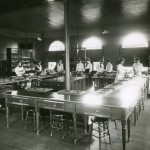The story of vocational teacher education at Ohio State begins in 1862 when President Lincoln signed into law the Morrill Act, which provided the necessary means of financing colleges of agricultural and mechanical arts. As America was recovering from the Civil War and the Industrial Revolution swept across the young country, The Ohio Agricultural and Mechanical College was established in 1870 within a farming community on the northern edge of Columbus. In 1878, the institution changed its name to The Ohio State University and diversified its curriculum by offering a wider range of classes.
Of the original organization within the university in the 1890s, the Department of Mechanic Arts was the area in which the early beginnings of Vocational Education existed. By the 1916-1917 school year, a four year Manual Training degree was being offered by the university – the first clear sign of a developing vocational teacher curriculum beyond agriculture. As society moved further from agrarian to industrial around the turn of the century, one man from Ohio State’s mechanical engineering department was championing for Vocational Education in Ohio’s public school system. William T. Magruder was active as President of the Ohio branch of the National Society for the Promotion of Industrial Education (renamed the American Vocational Association in 1926), which advocated greater awareness for the national need for vocational curricula in America’s schools and to secure federal aid to develop and promote such a program. (Ohio Department of Education, 1997). This vocational organization is often credited with the flood of federal legislation and aid in the early 20th century that culminated in the passing of the Smith-Hughes Act of 1917, which had the following purpose:
“To provide for the promotion of Vocational Education; to provide for cooperation with the states in the promotion of such education in agriculture and trade and the industries; to provide for cooperation with the states in the preparation of teachers of vocational subjects; and to appropriate money and regulate its expenditure” (Johnston, 1970, p. 12).
One of the appointees to the first State Board of Vocational Education in 1917 was Alfred Vivian, Dean of the College of Agriculture at OSU, who was also a fierce advocate of Vocational Education in secondary schools and teacher training within the university. It was this State Board that was able to secure $2.5 million in federal aid during the first year of Smith-Hughes for Ohio (Ohio Department of Education, 1997). While there had already been an industrial education program operating in Hayes Hall since 1893, the Smith-Hughes Act signals the first significant financial aid to William T. Magruder’s vision of universal Vocational Education, as the funds made possible a Vocational Education program within the College of Education (Johnston, 1970). As we will see in the following years, this piece of legislation opens the proverbial flood gates of federal aid to Vocational Education programs across the nation.






